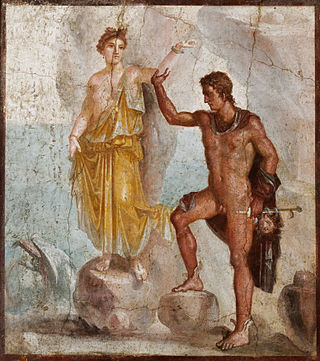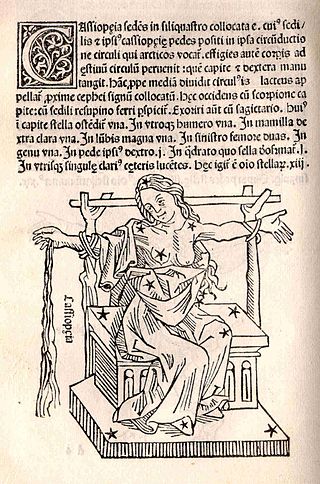
In Greek mythology, Andromeda is the daughter of Cepheus, the king of Aethiopia, and his wife, Cassiopeia. When Cassiopeia boasts that she is more beautiful than the Nereids, Poseidon sends the sea monster Cetus to ravage the coast of Aethiopia as divine punishment. Andromeda is chained to a rock as a sacrifice to sate the monster, but is saved from death by Perseus, who marries her and takes her to Greece to reign as his queen.

A Flamsteed designation is a combination of a number and constellation name that uniquely identifies most naked eye stars in the modern constellations visible from southern England. They are named for John Flamsteed who first used them while compiling his Historia Coelestis Britannica.

Andromeda is one of the 48 constellations listed by the 2nd-century Greco-Roman astronomer Ptolemy, and one of the 88 modern constellations. Located in the northern celestial hemisphere, it is named for Andromeda, daughter of Cassiopeia, in the Greek myth, who was chained to a rock to be eaten by the sea monster Cetus. Andromeda is most prominent during autumn evenings in the Northern Hemisphere, along with several other constellations named for characters in the Perseus myth. Because of its northern declination, Andromeda is visible only north of 40° south latitude; for observers farther south, it lies below the horizon. It is one of the largest constellations, with an area of 722 square degrees. This is over 1,400 times the size of the full moon, 55% of the size of the largest constellation, Hydra, and over 10 times the size of the smallest constellation, Crux.

Cassiopeia is a constellation and asterism in the northern sky named after the vain queen Cassiopeia, mother of Andromeda, in Greek mythology, who boasted about her unrivaled beauty. Cassiopeia was one of the 48 constellations listed by the 2nd-century Greek astronomer Ptolemy, and it remains one of the 88 modern constellations today. It is easily recognizable due to its distinctive 'W' shape, formed by five bright stars.

Lacerta is one of the 88 modern constellations defined by the International Astronomical Union. Its name is Latin for lizard. A small, faint constellation, it was defined in 1687 by the astronomer Johannes Hevelius. Its brightest stars form a "W" shape similar to that of Cassiopeia, and it is thus sometimes referred to as 'Little Cassiopeia'. It is located between Cygnus, Cassiopeia and Andromeda on the northern celestial sphere. The northern part lies on the Milky Way.

Pegasus is a constellation in the northern sky, named after the winged horse Pegasus in Greek mythology. It was one of the 48 constellations listed by the 2nd-century astronomer Ptolemy, and is one of the 88 constellations recognised today.
Augustin Royer was a French architect who lived in the time of Louis XIV.

Honores Friderici or Frederici Honores, also called Gloria Frederica or Frederici was a constellation created by Johann Bode in 1787 to honor Frederick the Great, the king of Prussia who had died in the previous year. It was between the constellations of Cepheus, Andromeda, Cassiopeia and Cygnus. Its most important stars were Iota, Kappa, Lambda, Omicron, and Psi Andromedae. The constellation is no longer in use.

Sceptrum Brandenburgicum was a constellation created in 1688 by Gottfried Kirch, astronomer of the Prussian Royal Society of Sciences. It represented the scepter used by the royal family of the Brandenburgs. It was west from the constellation of Lepus. The constellation was quickly forgotten and is no longer in use. Its name was, however, partially inherited by one of its brightest stars, Sceptrum, which today is denoted 53 Eridani. This name is still in use today.

51 Andromedae, abbreviated 51 And and formally named Nembus, is the 5th brightest star in the northern constellation of Andromeda, very slightly dimmer than the Andromeda Galaxy also being of 4th magnitude. It is an orange K-type giant star with an apparent magnitude of +3.57 and is about 169 light-years from the Earth/solar system. It is traditionally depicted as one of the two northern, far upper ends of the mythological, chained-to-the-rocks princess, the other being binary star system Gamma Andromedae.
53 Eridani, also designated l Eridani, is a binary star in the constellation of Eridanus. The system has a combined apparent magnitude of 3.87. Parallax estimates made by the Hipparcos spacecraft put it at a distance of about 110 light-years, or 33.7 parsecs, from the Sun.

The following outline is provided as an overview of and topical guide to astronomy:
Chinese star names are named according to ancient Chinese astronomy and astrology. The sky is divided into star mansions and asterisms. The system of 283 asterisms under the Three Enclosures and Twenty-Eight Mansions was established by Chen Zhuo of the Three Kingdoms period, who synthesized ancient constellations and the asterisms created by early astronomers Shi Shen, Gan De and Wuxian. Since the Han and Jin dynasties, stars have been given reference numbers within their asterisms in a system similar to the Bayer or Flamsteed designations, so that individual stars can be identified. For example, Deneb is referred to as 天津四.

Former constellations are old historical Western constellations that for various reasons are no longer widely recognised or are not officially recognised by the International Astronomical Union (IAU). Prior to 1930, many of these defunct constellations were traditional in one or more countries or cultures. Some only lasted decades but others were referred to over many centuries. All are now recognised only for having classical or historical value. Many former constellations had complex Latinised names after objects, people, or mythological or zoological creatures. Others with unwieldy names were shortened for convenience. For example, Scutum Sobiescianum was reduced to Scutum, Mons Mensae to Mensa, and Apparatus Sculptoris to Sculptor.

Star lore or starlore is the creating and cherishing of mythical stories about the stars and star patterns ; that is, folklore based upon the stars and star patterns. Using the stars to explain religious doctrines or actual events in history is also defined as star lore. Star lore has a very long history; it has been practiced by nearly every culture recorded in history, dating as far back as 5,500 years ago. It was practiced by prehistoric cultures of the Paleolithic and Neolithic periods as well.
The modern constellation Andromeda lies across two of the quadrants, symbolized by the Black Tortoise of the North and the White Tiger of the West, that divide the sky in traditional Chinese uranography.
According to traditional Chinese uranography, the modern constellation Lacerta is located within the northern quadrant of the sky, which is symbolized as the Black Tortoise of the North.

Urania's Mirror; or, a view of the Heavens is a set of 32 astronomical star chart cards, first published in November 1824. They are illustrations based on Alexander Jamieson's A Celestial Atlas, but the addition of holes punched in them allow them to be held up to a light to see a depiction of the constellation's stars. They were engraved by Sidney Hall, and were said to be designed by "a lady", but have since been identified as the work of the Reverend Richard Rouse Bloxam, an assistant master at Rugby School.

Cassiopeia or Cassiepeia, a figure in Greek mythology, was Queen of Aethiopia and wife of King Cepheus. She was arrogant and vain, characteristics that led to her downfall.












